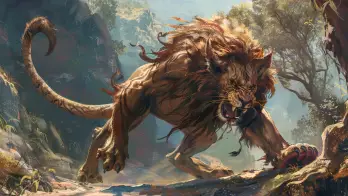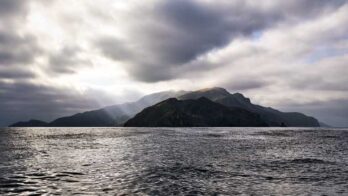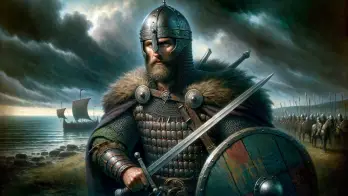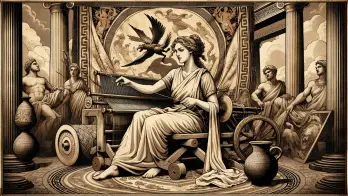Emerging from the chilling waters of maritime folklore, especially prevalent in Northern European tales, the massively powerful Kraken has carved a space for itself in global consciousness. This colossal sea monster’s legend has been a testament to humanity’s fascination with the abyss and the unknown dangers lurking beneath. Its longevity in the public consciousness, from early seafaring eras through to a pop culture obsessed post-modern age speaks to the enduring nature of the shadow cast by this mythological giant.
Historical Origins and Evolution
The Kraken’s roots are intertwined with tales from Scandinavian folklore. Skaldic poems and Old Norse sagas, such as the Orvar-Oddr saga, contain potential references to this sea monster or creatures like it, forming some of the earliest cornerstones of its mythos.
Later in literature, Erik Pontoppidan published his Natural History of Norway in 1752 and 1753, which proposed the existence of the Kraken, as well as sea serpents and mermaids – further exciting a sense of mystery and intrigue among the general public. Pontoppidan’s detailed account gave the Kraken a broader European audience. His depiction, based on mariner accounts and myths, emphasized the sheer size of the creature, proposing an organism so vast that sailors often mistook it for islands.
As the creature’s proposed existence took hold of the European imagination, it was featured in other works from the continent in the 18th Century and beyond, including the French Denys de Montfort’s “Histoire Naturelle Générale et Particulière des Mollusques” in the early 1800s. These volumes perpetuated the Kraken image, further entrenching its legend.
Artistic and Descriptive Imagery
Perhaps astoundingly, the Kraken found itself straddling the border between myth and reality when early visual representations of the creature started to appear even within the pages of credible scientific publications, such as the legendary Systema Naturae by Carolus Linnaeus. Within that text, illustrations depict the Kraken as a huge creature with tentacles sprawling menacingly. Fascinatingly, the Kraken is even assigned a scientific name, classified as a cephalopod with the name Microcosmus marinus.
Further visual depictions appeared on maps of the oceans. The British cartographer Bishop John Barrett’s maps, like the Tabula Geographica, often incorporated these sea monsters, echoing mariner fears.
In the written form, the Kraken was also given life. From mariners’ logbooks to travel diaries, many described encounters with vast sea creatures, fortifying the Kraken’s legend. Its immense size and tentacles became the most defining features, casting it as nature’s behemoth. Even the famed author of Moby Dick, Herman Melville, referred to the epic scale and ferocity of the Kraken within his writing, helping to carry the legend into the modern age.
Zoological Inspirations and Discoveries
While the Kraken is a mythological creature that has provided no evidence of its existence (at least not at the scale depicted in the works above), there are a number of real creatures whose features and behaviors reflect aspects of the legend. Huge whales, such as the Blue Whale, are among the largest animals ever to have existed on Earth, and encounters with these majestic creatures during a lengthy sea voyage could be the source of some of the tales.
Furthermore, perhaps the most visually similar comparison can be drawn to the largest of the cephalopods. Scientists, exploring the deep seas, have unveiled real-life creatures like the giant squid, which align with the Kraken’s descriptions. Rare encounters with these beings, particularly in the waters around Newfoundland, provide tangible links. Reference: Smithsonian Magazine
Larger and even more mysterious than its counterpart, the colossal squid, found in the Antarctic’s deeper parts, intensifies the Kraken mythos with its enormity and fearsome tentacle hooks. Recent discoveries of these creatures, particularly by New Zealand’s fishing vessels, have reignited Kraken discussions. Reference: BBC
Modern Adaptations and Depictions
In modern literature, Jules Verne’s 20,000 Leagues Under the Sea introduced Captain Nemo’s terrifying encounter with a giant squid while trapped deep underwater, further cementing the Kraken’s literary legacy. Even more recently, China Miéville’s Kraken is a modern novel steeped in the creature’s lore, set against the backdrop of a fantastical London.
Outside of the written word, the sea beast has been a staple of visual media, such as film, television and even video games. From its early cinematic presence in films like 20,000 Leagues Under the Sea (1954), the Kraken’s influence has proliferated. TV series’ like Lost Tapes on Animal Planet showcase mockumentary-style encounters with the beast, while others like River Monsters seek a more factual basis, delving into real-life creatures that might have inspired the myth. Very recently, the creature was even reinvented for a young audience in the animated comedy Ruby Gillman, Teenage Kraken (2023).
In the realm of video games, the epic scale of “God of War,” an acclaimed video game, showcases sea monsters that echo the Kraken’s descriptions, offering players intense battles. The Kraken’s influence isn’t limited to digital realms; board games like “Tentacle Bento” and “Abyss” utilize its imagery prominently.
Symbolism and Cultural Impact
So, why has this legend persisted for so long? What is it about the mighty Kraken that so effectively taps into the human psyche? Following are a few possible symbolic connections that help to keep the creature relevant for audiences of all ages:
- Man vs. Nature: Through the lens of marine literature, the Kraken embodies the ancient struggle between seafarers and the tempestuous sea. It’s a testament to tales of survival, the unpredictable nature of the oceans, and man’s minuteness in nature’s vast tableau.
- Psyche’s Abyss: Beyond Jungian analysis, even Freudian interpretations see the Kraken as a leviathan from our id – an embodiment of suppressed desires and fears that occasionally bubble to the surface, often with disruptive effects.
- Modern Metaphors: In contemporary discourse, the term “releasing the Kraken” has been utilized in contexts ranging from sports to politics, denoting the unleashing of formidable power or strategies. The creature serves as an apt metaphor for unbridled, often unexpected forces or interventions.
Final Thoughts
The Kraken’s tentacles stretch far beyond its maritime origins, reaching into the realms of psychology, popular culture, and modern metaphorical discourse. As we delve deeper into our oceans with advancing technology, unveiling more mysteries, the Kraken’s myth serves as a reminder of our world’s vast wonders and the tales born from the human quest to understand the unknown. It’s a blend of fear, respect, and intrigue, echoing through centuries and likely to persist as we continue our exploration of both our external and internal worlds.
At Ancient Theory we only use trusted sources to document our articles. Such relevant sources include authentic documents, newspaper and magazine articles, established authors, or reputable websites.
- Örvar-Odds saga
- Forsøk til Norges naturlige historie ("The Natural History of Norway") by Erik Pontoppidan (1752-1753)
- "Histoire Naturelle Générale et Particulière des Mollusques" by Denys de Montfort
- "Systema Naturae" by Carolus Linnaeus
- "Tabula Geographica" by Bishop John Barrett
- The Giant Squid: Dragon of the Deep (Smithsonian Magazine) [Source]
- A rare chance to examine a colossal squid (BBC video) [Source]
- "20,000 Leagues Under the Sea" by Jules Verne
- "Kraken" by China Miéville






